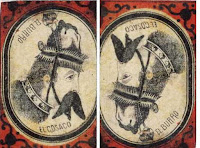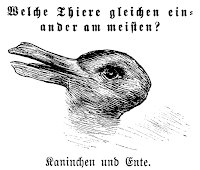Ambiguous Image of Three Men, Two Women and a Goat, early 20th Century
Artist unknown
Possibly chromolithograph; 5 3/4 x 5 1/4 x 1/2 in.
6490
Gift of Mrs. H. Merritt Adamson
He lived as a devil, eh? It’s far from often that we come across palindromes like the preceding sentence, phrases which can be inverted to spell out the same message as they would have if written forwards; it’s rarer still to come across an image intended to be turned on its head. This April Fool’s Day we revel in reversals and mischief and look at two miniature ‘topsy-turvy pictures’ from the turn of the 20th Century.
 |
|
Ambiguous Image of Four Men, One Women and a Donkey, early 20th Century
Artist unknown
Possibly chromolithograph; 6 x 5 5/8 x 5/8 in.
6489
Gift of Mrs. H. Merritt Adamson
|
 |
| Matchbook for unknown brand, c. 1920 |
The subject material of these pictures is as delightful as it is confusing. Between the two images a cumulative six bearded men can be rotated 180⁰ to become wigged women, donkeys, and even a curious-looking goat. Clothed in a blue and white linen hood, ruff, feathered hats, and inconspicuously disguised donkey headgear; these characters appear to be dressed in stage-costumes that would have been anachronistic years before their suspected make. The objects’ lack of 3-dimensional texturing, the presence of striations, and the general style seem to indicate that the two are chromolithographs, which would place them sometime between the turn of the 20th Century and as late as the 1930s. The content, time period, and that both images were hand-cut to be inserted into their frames make it likely that the two were originally prints created to advertise something: a theater production, miracle beard-grow tonic—a rationale for the overwhelming number of hairy faces seen in the two topsy-turvies—razors, or matches like the above Spanish-language brand with a strikingly similar man-donkey to what’s seen in our Ambiguous Image of Four Men, One Woman and a Donkey; these are all possible candidates.
 |
|
Rabbit and Duck, in Fliegende Blätter, October 1892
|
As with all other modes of fooling, these images affect the mind. The technical term for the ‘topsy-turvy’ colloquialism is ambiguous image, but its implications are more psychological than art-historical. These duplicitous images trigger a phenomenon upon viewing known as multistable perception; a complex way of saying that when an image forms two or more separate visual concepts then only one of them can be perceived at a time. Perhaps the best-known example of this gestalt is the Rabbit and Duck illusion published in an 1892 issue of a German humor magazine.
 |
|
Allegory of Winter, early 17th Century
Joost de Momper the Younger (Flemish, 1564–1635)
Oil on panel; 20.7 × 15.6 in
Private Collection
|
Artists though, have been practicing this form of optical illusion for at least hundreds of years. In the early 17th Century one of the most important Flemish landscape painters, Joost de Momper the Younger (1564–1635), painted mountain villages anthropomorphized as old, gnarled men as part of a series on seasons. Placing our own objects in a timeline of these works is difficult. It’s also complicated by the lack of documentation and that no other museum seems to house related topsy-turvies, but we can see a burgeoning of similar works throughout the interwar period. The above Spanish-language matchbox referencing Russian Cossacks was made in the 1920s, the same decade which saw the Indian brand Magic Head producing its own topsy-turvy design. Thematically similar and stylistically dissonant works were being made by English graphic artists such as Rex Whistler for publicity campaigns. Altogether we see that in addition to ambiguous images spanning art history, these topsy-turvies became a global craze in the early 20th century, right when we suspect our tricky pictures were made.
Mysterious as the Bowers Museum’s and other topsy-turvies may be, there is one consistent thread to be found in these images. A desire to entertain with subterfuge and duality. If only one more thing can be extrapolated from our objects, it’s that the devilish artist who made them would have taken great pleasure in knowing that they were still fooling to this day.
 |
|
Mayor & Judge, 1930
Reginald John "Rex" Whistler (1905–1944)
Part of series of ‘reversible faces’ for Shell Petroleum
|
Text and images may be under copyright. Please contact Collection Department for permission to use. Information subject to change upon further research.







Comments